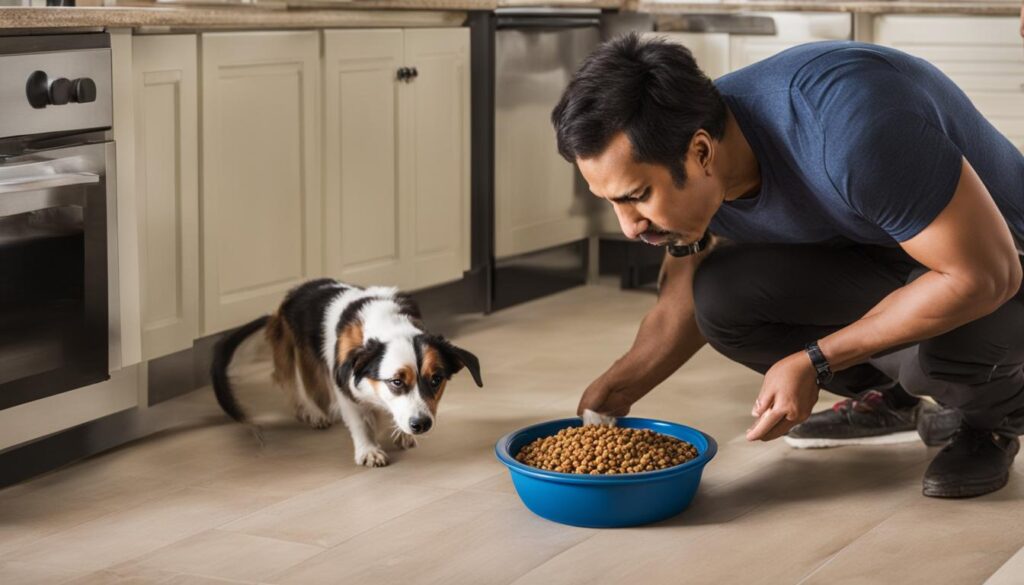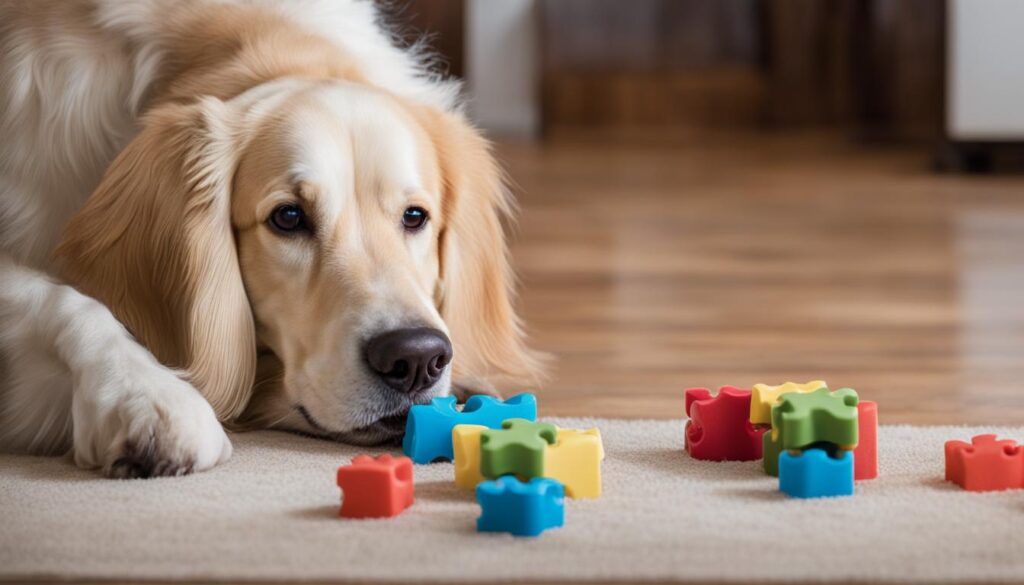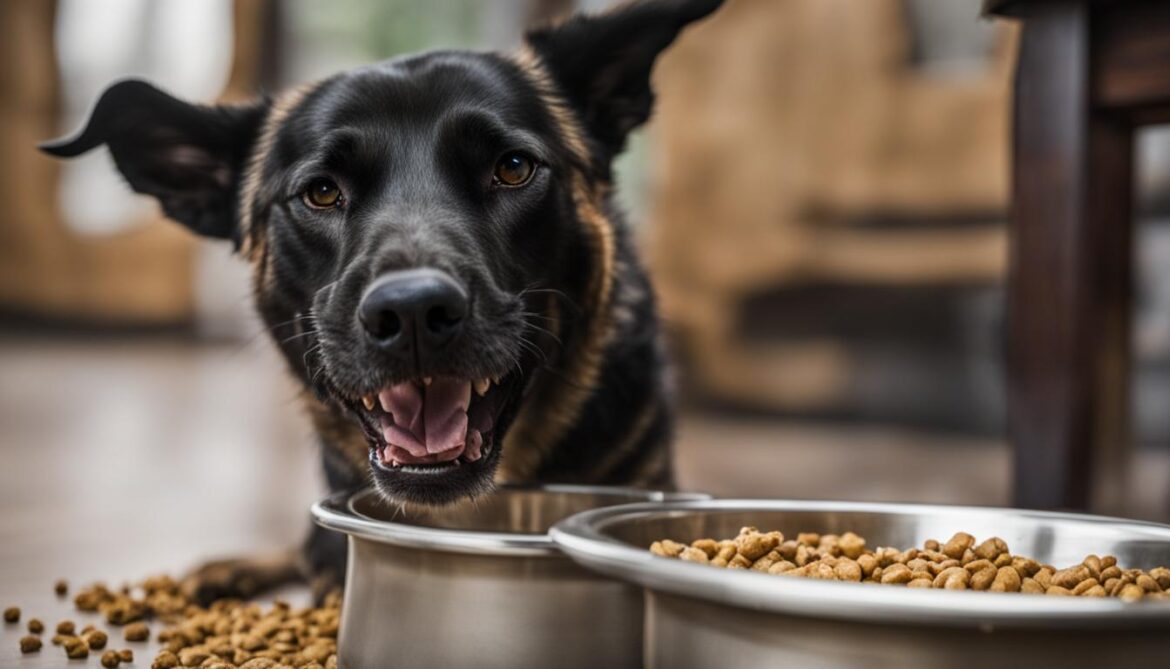As a dog owner, mealtimes are a crucial part of your furry friend’s daily routine. However, some dogs exhibit aggressive behavior around food, which can be concerning and even dangerous. Food aggression in dogs is a common occurrence, and it can take many different forms, from growling and snarling to biting and snapping.
Understanding the root causes of food aggression is the first step to managing this behavior effectively. In this article, we will explore the phenomenon of food aggression in dogs, its causes, and strategies for preventing and managing it.
Key Takeaways:
- Food aggression in dogs is a common issue that requires understanding and management.
- Aggressive behavior around food can take many forms, from growling to biting.
- Effective management of food aggression requires recognizing the signs, understanding the root causes, and implementing appropriate feeding strategies and behavior modification techniques.
- Patience, consistency, and expert guidance are crucial for addressing food aggression in dogs.
- By following the strategies outlined in this article, you can create a more peaceful mealtime for you and your furry companion.
Recognizing Signs of Food Aggression
Managing and preventing food aggression in dogs requires you to recognize the signs early on. By understanding the cues of food aggression, you can take steps to manage it effectively. Some common behavioral indicators of food aggression in dogs include:
- Growling or snarling while eating or near their food bowl
- Protective stance over their food or treats
- Stiffness in body language when near food
- Aggressive behavior towards other animals or humans when near food
If you notice any of these signs in your dog, it’s crucial to address it immediately to prevent the problem from escalating. Here are some tips for managing food aggression in dogs:
- Establish a regular feeding schedule to create a routine your dog can rely on.
- Do not leave food out all day, instead offer meals at specific times.
- Feed your dog in a quiet, isolated area where they can eat without distractions.
- Teach your dog to sit and wait before you give them their food bowl.
- Avoid approaching your dog when they are eating, especially children or other pets, to prevent any aggressive behavior.
Preventing food aggression in dogs should start when they are puppies. It’s crucial to establish good habits early on and train your dog to understand that you are in charge of the food. With proper training and consistent management, you can effectively prevent and manage food aggression in your furry friend.
Understanding the Root Causes
Dealing with food aggression in dogs requires a deep understanding of the causes that trigger aggressive behavior. Dogs can exhibit varying levels of aggression towards food, depending on the underlying causes, such as:
- Resource guarding – Dogs may become aggressive when they perceive their food as a valuable resource that needs to be protected. This behavior is often triggered by previous experiences of not having enough food, living in a chaotic environment, or a lack of proper socialization.
- Medical conditions – In some cases, food aggression can be a symptom of an underlying medical condition, such as pain or discomfort while eating.
- Behavioral issues – Some breeds are more prone to aggressive behavior than others, and some dogs may have learned this behavior from their environment or previous owners.
To address food aggression in dogs, training and behavior modification must be implemented. Training should focus on teaching your dog proper behaviors when it comes to food, using positive reinforcement methods. Consulting with a professional dog trainer or animal behaviorist can help you develop a training plan tailored to your dog’s specific needs.

“It’s important to understand that addressing food aggression in dogs requires time, effort, and patience. Training is an ongoing process, and consistency is key in reinforcing positive behaviors.”
One effective training technique is to teach your dog to associate a positive experience with their food. This involves gradually increasing the proximity of humans or other dogs during mealtimes, rewarding good behavior, and using a firm yet gentle voice to discourage negative behavior.
It’s important to avoid punishment-based training methods, as these can exacerbate aggression and lead to further behavioral problems in the long run.
Managing food aggression in dogs is crucial for promoting a safe and harmonious environment for both you and your furry companion. By understanding the underlying causes, seeking professional guidance, and using positive reinforcement training techniques, you can help your dog overcome food aggression and enjoy a happier, healthier life.
Implementing Feeding Strategies
When dealing with food aggression in dogs, implementing appropriate feeding strategies can help.
One effective feeding strategy for aggressive dogs is to use a puzzle feeder. This type of feeder requires the dog to work for their food, slowing down the eating process and reducing the intensity of their behavior. Puzzle feeders can be purchased or easily made at home with household items.
Another strategy is to hand-feed your dog. This allows you to establish trust and reinforce positive behavior during mealtimes.
It’s also important to establish a feeding routine. This means feeding your dog at the same time and in the same location every day. Dogs thrive on routine, and this can help reduce anxiety and prevent aggressive behavior during mealtimes.
Avoid free-feeding, where food is always available to your dog. This can lead to overeating and increase the likelihood of food aggression.

Controlling the environment during mealtimes is also crucial. Feed your dog in a quiet, low-traffic area away from distractions and other animals. If you have multiple dogs, feed them separately to prevent competition for food.
By implementing these feeding strategies, you can reduce your dog’s food aggression and promote a more peaceful mealtime.
Behavior Modification Techniques
Behavior modification is a process of identifying and changing negative behaviors in dogs. This approach can be highly effective in managing food aggression, helping your furry friend to develop a more positive and relaxed relationship with food. Here are some tips that can help:
- Dog food aggression training: Professional training can be incredibly beneficial in helping your dog overcome food aggression. A qualified dog trainer can work with you and your pet to identify the root causes of the behavior and develop a customized training program to target them. With patience and consistency, this approach can be highly effective in resolving food aggression issues.
- How to stop food aggression in dogs: One effective strategy for stopping food aggression in dogs is to use positive reinforcement training techniques. This involves rewarding your dog for good behavior, such as sitting calmly during meal times or waiting patiently for food. By focusing on positive behavior, you can encourage your dog to associate meal times with positive experiences, reducing the likelihood of aggressive behavior.
- Tips for handling food aggression: When dealing with food aggression, it’s important to be patient and understanding with your pet. Avoid punishing or scolding your dog, as this can make the behavior worse. Instead, focus on positive reinforcement and reward-based training techniques to encourage good behavior.
- Managing food aggression in pets: Effective management strategies can also help to mitigate food aggression in dogs. For example, rather than leaving food out all day, try feeding your dog smaller meals at set times throughout the day. This can help your pet to associate meal times with structure and routine, reducing the likelihood of aggressive behavior.
Remember, behavior modification is a process that requires patience and consistency. With time and effort, you can help your furry friend to overcome food aggression and develop a healthier, more positive relationship with food.
Conclusion
Congratulations on taking the first step towards understanding and managing food aggression in dogs. By recognizing the signs of food aggression and addressing the root causes, you can create a safer and more peaceful mealtime environment for your furry friend.
Remember, implementing appropriate feeding strategies and using behavior modification techniques play a crucial role in managing food aggression in dogs. With patience, consistency, and expert guidance, you can help your dog overcome this issue and improve their overall behavior.
It’s important to reiterate that food aggression in dogs can be a serious issue that requires professional guidance. If you’re struggling to manage your dog’s food aggression, consider consulting with a certified trainer or behaviorist who specializes in this area.
Thank you for taking the time to learn about food aggression in dogs. By working together, we can create a safer and happier environment for all our furry companions.
FAQ
What is food aggression in dogs?
Food aggression in dogs refers to the behavior where a dog becomes possessive or aggressive around food. This may include growling, snarling, snapping, or even biting to protect their food from humans or other animals.
How can I recognize signs of food aggression in my dog?
Signs of food aggression in dogs can include guarding food bowls, growling or snarling when approached while eating, stiff body language, and showing aggression towards other animals or people near their food.
What are the root causes of food aggression in dogs?
Food aggression in dogs can stem from various factors, including fear, a history of limited access to food, lack of socialization, or resource guarding tendencies. Understanding these underlying causes is essential for addressing and managing the behavior.
Are there feeding strategies that can help with food aggression?
Yes, implementing certain feeding strategies can help manage food aggression in dogs. This may include feeding in separate areas or using puzzle toys to extend mealtime and promote a calmer feeding environment.
How can behavior modification techniques help with food aggression?
Behavior modification techniques can be effective in addressing food aggression. This may involve positive reinforcement training, desensitization, or counterconditioning methods to change your dog’s response to food-related situations.
What can I do to prevent food aggression in my dog?
Preventing food aggression involves proper socialization, establishing a consistent feeding routine, avoiding free-feeding, and teaching your dog impulse control and obedience commands. It is also important to avoid any confrontational or punitive methods that may exacerbate the aggression.
